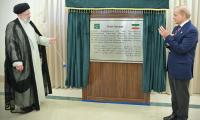The alarming thing about the political discourse in Pakistan today is that it is divorced from the two bookends within which public policy should be framed and conducted at all times in this Islamic Republic.
At one end of this spectrum is the micro: the interests of the individual Pakistani, her ability to survive a pandemic-stricken global economy, and a rule of law compromised village, town or city; her ability to pay for the things she and her family need; and her capacity to maintain the conviction that her children’s future or her nieces and nephews’ future will be better than her present.
At the other end of this spectrum is the macro: the capacity of Pakistan to continue to keep an unrelenting and insatiable enemy at bay, to defend and secure the frontiers as well as the streets, the masajid and imambargahs and gurdwaras and temples and churches, and the capability of the intelligence community to not only thwart attempts to sow discord between Pakistanis, but also to successfully evade being dragged into micro and meso debates and conflicts that compromise the Pakistani state’s objectivity and its stature and prestige.
The political parties that call themselves the opposition claim that the authority and agency of the ‘micro’, the individual Pakistani, is sacrosanct to them, and hence their obsessive focus on the fidelity of the individual vote.
The ruling structure that calls itself the government claims that the protection of the ‘macro’, the security and integrity of the Republic, is above all, and hence its obsession with tagging all those that stand against this ruling structure as traitors, disloyal both to the macro, the state itself, and the micro, the individual Pakistani.
The opposition and the ruling structure are both indulging in a fair bit of dissemblance as they make these claims. The common thread across both of them is not their stand for the individual rights of the Pakistani nor their service to the coherence, unity and strength of the republic. The common thread across both of them is the pursuit of the upper hand in the short-term competition of narratives, so as to help secure and sustain power over a public sector that is largely dysfunctional to the point of requiring special initiatives and interventions for both business-as-usual as well as emergencies.
Almost everything resembling good governance in Pakistan in the last twelve years is a product of extraordinary compromises and initiatives, with almost no concurrent reform to help ensure that ‘what should be’ is normal. Instead, the ‘what should be’ is achieved through pathways and individuals that stand out, and are, for lack of a better word, abnormal.
From 2008 to 2013, Pakistan’s fragile system was held together through the Presidency, rather than through parliament, or the cabinet or the executive. The fact that the system was able to withstand terrorism during that period, as well as the global pressure on Pakistan, as well as the impact of the global financial crisis, as well as the transition from a centralized to a truly federal system – all in a space of five years is – looking back, almost unbelievable.
These achievements came at a great cost to the people of Pakistan, the 200 million or so ‘micros’. They also came at a great cost to the ‘macro’: tens of thousands of soldiers and spies were killed, our internal unity was put in a blender, our democratic norms were stretched, and damaging and toxic new narratives found permanent oxygen.
From 2013 to 2018, Pakistan achieved some incredible wins. The two biggest are now taken for granted, but they should not be: beating terrorism and turning the lights back on. The terrorists that had destroyed the country by 2013 had only another year or so of space before time was up. The summer of 2014 saw the beginning of the end of organized terror as a threat to the Pakistani order, and the APS attack of December 16, 2014 fast-tracked that process. The win against terrorism came at a great price – paid by the families of our armed forces and police system, and by the people of the newly merged districts, as well as Balochistan.
The surge in the capacity to generate electricity is the other. Through the first decade of the 21st century, Pakistan often resembled the ultimate development basket case, held back not only by conflict, incompetence and poor leadership, but by restricted physical capacity to do the things a normal country should be able to do: first and foremost of which is to keep the lights on. In 2013, loadshedding – even in the toniest neighborhoods of the country – often consumed over 12 hours a day. By the end of 2017, there were many parts of the country with zero hours of loadshedding. This achievement also came at a great cost. The companies that helped build up the capacity to generate much more megawattage came away with large, guaranteed profits. The public debt that has accumulated as a result eats away the country’s economic capability.
What lessons should Pakistani elites have learnt from this decade of compromised wins? Perhaps the most important lesson was that to achieve anything meaningful required the jettisoning of how things are normally done, and adopting extraordinary measures. The list is long and distinguished: federalism, national security, and infrastructure all saw major gains in this decade.
To achieve the 18th Amendment and the NFC required a suspension of regular political discourse in favour of coherence and unity among the political class. To win the ‘war on terror’ required the suspension of normalcy as far as constitutional values are concerned, with military courts and extrajudicial killings replacing traditional law enforcement and terrorists having to stand trial and be punished for their crimes. To rapidly build infrastructure required low cost financial capital from China, and the creation of special companies that were not vulnerable to red tapism, where extraordinary civil servants were deployed to achieve results quickly and efficiently.
The biggest lesson from Pakistani governance circa 2008-2018 was that even a completely broken and dysfunctional system can be mobilized to achieve grand objectives as long as there is a clarity of purpose, and the price of this mobilization is deemed to be worthy of paying.
The price of unison and consensus on federalism is top-heavy political parties like the PPP and PML-N. The price of winning a war on terror is compromised civil liberties and a highly paranoid national security discourse. The price of quickly adding to the national grid’s capacity to generate electricity is expensive electricity. The price of quick-fix companies to bypass traditional red tape and bureaucracy is the vulnerability of those companies to allegations of corruption.
But each of those prices has helped deliver a tangible outcome that both partisans and non partisans can clearly identify and point to: the 18th Amendment, a defeated TTP and LeJ, and dramatically less loadshedding.
Since 2018, Pakistan has been paying a price. Economic conservatism and deficit hawks have helped bring about higher sustained inflation than Pakistan has had in over a decade. Civil military unity and the ‘one page’ have constricted the oxygen for a free and open discourse. Winning the talk-show wars at all costs has meant that the cabinet and the PM Office are stacked with trolls, instead of thoughtful reformers. So the price Pakistan is paying is clear.
The big question for the ruling structure, including but not limited to the prime minister, is what this price is for. What is the payoff? What is being gained at this expense?
We must be able to point to the gains made when people endure the things individual Pakistanis have to endure, and when a country endures the kinds of systemwide threats that Pakistan has to endure.
A political discourse that continually seeks to continue debating the price of things without being able to identify what is gained is in deep trouble.
The writer is an analyst and commentator.
An aeroplane of the national flag carrier of Pakistan is seen in this file photo. — AFPWhile Pakistan considers...
Representational image of a graph depicting various variables. — APP/FileInitiated by the centre and fiercely...
In this picture taken on April 16, 2023, people throng a market area during shopping in Lahore. — AFPOne of the...
Honour crimes also target men. In Sikandar Ali Lashari vs The State, SHC upheld conviction passed by ATC for honour...
If Sindh earmarks Rs20 million per police station, it will cost only Rs10 billion to make them effective first...
A complex and difficult policy environment seems to be highlighted by US’s recent application of sanctions on...







